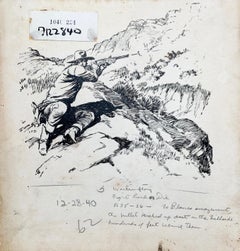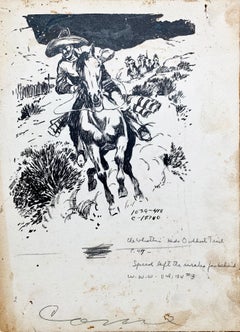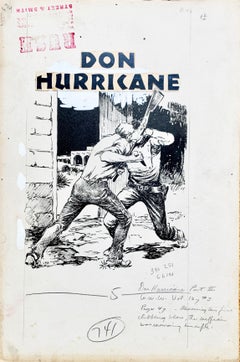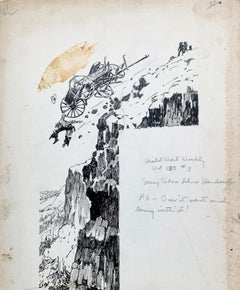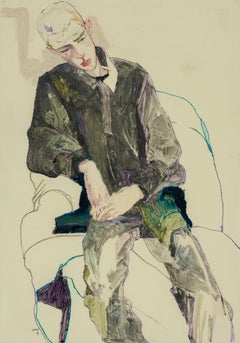Lorence Bjorklund Art
to
11
10
1
11
Overall Height
to
Overall Width
to
11
7
5
4
3
3
1
1
1
1
1
1
1
1
11
5
6
11
6,844
3,161
2,517
1,217
11
Artist: Lorence Bjorklund
Lorence Bjorklund "Trail Bros", ink on illustration board
By Lorence Bjorklund
Located in Glenview, IL
"Trail Bros" by Swedish American pulp artist Lorence Bjorklund (1913 - 1978) is an ink drawing on illustration board representing a western scene som...
Category
1950s Other Art Style Lorence Bjorklund Art
Materials
Ink
Lorence Bjorklund "Fight Back or Die", original ink on illustration board
By Lorence Bjorklund
Located in Glenview, IL
"Fight Back or Die" by Swedish American pulp artist Lorence Bjorklund (1913 - 1978) is an ink drawing on illustration board representing a male figur...
Category
1940s Other Art Style Lorence Bjorklund Art
Materials
Ink
Lorence Bjorklund "The Whistlin' Kids ... Trail", ink on illustration board
By Lorence Bjorklund
Located in Glenview, IL
"The Whistlin' Kids (illegible) Trail " by Swedish American pulp artist Lorence Bjorklund (1913 - 1978) is an ink drawing on illustration board repre...
Category
1940s Other Art Style Lorence Bjorklund Art
Materials
Ink
Lorence Bjorklund "Don Hurricane", original ink on illustration board
By Lorence Bjorklund
Located in Glenview, IL
"don Hurricane" by Swedish American pulp artist Lorence Bjorklund (1913 - 1978) is an ink drawing on illustration board representing two fighting mal...
Category
1940s Other Art Style Lorence Bjorklund Art
Materials
Ink
Lorence Bjorklund "Gold Robbers of Cutthroat Gulch", ink on illustration board
By Lorence Bjorklund
Located in Glenview, IL
"Gold Robbers of Cutthroat Gulch" by Swedish American pulp artist Lorence Bjorklund (1913 - 1978) is an ink drawing on illustration board representin...
Category
1940s Other Art Style Lorence Bjorklund Art
Materials
Ink
Lorence Bjorklund "Sonny Tabor's Silver Handcuffs", ink on illustration board
By Lorence Bjorklund
Located in Glenview, IL
"Sonny Tabor's Silver Handcuffs" by Swedish American pulp artist Lorence Bjorklund (1913 - 1978) is an ink drawing on illustration board representing...
Category
1940s Other Art Style Lorence Bjorklund Art
Materials
Ink
Lorence Bjorklund "Gun Shots of Skeleton Canyon", ink on illustration board
By Lorence Bjorklund
Located in Glenview, IL
"Gun Shots of Skeleton Canyon" by Swedish American pulp artist Lorence Bjorklund (1913 - 1978) is an ink drawing on illustration board representing, as the title suggests a shoot-out somewhere in the "Wild West".
Born in Minnesota, Bjorklund was best known for his western pulp illustrations...
Category
1950s Other Art Style Lorence Bjorklund Art
Materials
Ink
Lorence Bjorklund "Smokey Serenade", ink on illustration board
By Lorence Bjorklund
Located in Glenview, IL
"Smokey Serenade" by Swedish American pulp artist Lorence Bjorklund (1913 - 1978) is an ink drawing on illustration board representing two scenes: in...
Category
1950s Other Art Style Lorence Bjorklund Art
Materials
Ink
Lorence Bjorklund "A Gun Lawyer for CJ", ink on illustration board
By Lorence Bjorklund
Located in Glenview, IL
"A Gun Lawyer for CJ" by Swedish American pulp artist Lorence Bjorklund (1913 - 1978) is an ink drawing on illustration board representing what appears to be a gun battle under a via...
Category
1950s Other Art Style Lorence Bjorklund Art
Materials
Ink
Lorence Bjorklund "Shawn of the Gun Pack", ink on illustration board
By Lorence Bjorklund
Located in Glenview, IL
"Shawn of the Gun Pack" by Swedish American pulp artist Lorence Bjorklund (1913 - 1978) is an ink drawing on illustration board representing a shoot-...
Category
1950s Other Art Style Lorence Bjorklund Art
Materials
Ink
Lorence Bjorklund "Firebrand's Brothill Bounty", ink on illustration board
By Lorence Bjorklund
Located in Glenview, IL
"Firebrand's Brothill Bounty" by Swedish American pulp artist Lorence Bjorklund (1913 - 1978) is an ink drawing on illustration board representing a ...
Category
1950s Other Art Style Lorence Bjorklund Art
Materials
Ink
Related Items
The Abduction of the Sabine Women , a Renaissance drawing by Biagio Pupini
Located in PARIS, FR
This vigorous drawing has long been attributed to Polidoro da Caravaggio: The Abduction of the Sabine Women is one of the scenes that Polidoro depicted between 1525 and 1527 on the façade of the Milesi Palazzo in Rome. However, the proximity to another drawing inspired by this same façade, kept at the Ecole des Beaux-Arts, and to other drawings inspired by Polidoro kept at the Musée du Louvre, leads us to propose an attribution to Biagio Pupini, a Bolognese artist whose life remains barely known, despite the abundant number of drawings attributed to him.
1. Biagio Pupini, a Bolognese artist in the light of the Roman Renaissance
The early life of Biagio Pupini, an important figure of the first half of the Cinquecento in Bologna - Vasari mentions him several times - is still poorly known. Neither his date of birth (probably around 1490-1495) nor his training are known. He is said to have been a pupil of Francesco Francia (1450 - 1517) and his name appears for the first time in 1511 in a contract with the painter Bagnacavallo (c. 1484 - 1542) for the frescoes of a church in Faenza. He then collaborated with Girolamo da Carpi, at San Michele in Bosco and at the villa of Belriguardo.
He must have gone to Rome for the first time with Bagnacavallo between 1511 and 1519. There he discovered the art of Raphael, with whom he might have worked, and that of Polidoro da Caravaggio. This first visit, and those that followed, were the occasion for an intense study of ancient and modern art, as illustrated by his abundant graphic production.
Polidoro da Caravaggio had a particular influence on the technique adopted by Pupini. Executed on coloured paper, his drawings generally combine pen, brown ink and wash with abundant highlights of white gouache, as in the drawing presented here.
2. The Abduction of the Sabine Women
Our drawing is an adaptation of a fresco painted between 1525 and 1527 by Polidoro da Caravaggio on the façade of the Milesi Palace in Rome. These painted façades were very famous from the moment they were painted and inspired many artists during their stay in Rome. These frescoes are now very deteriorated and difficult to see, as the palace is in a rather narrow street.
The episode of the abduction of the Sabine women (which appears in the centre of the photo above) is a historical theme that goes back to the origins of Rome and is recounted both by Titus Livius (Ab Urbe condita I,13), by Ovid (Fasti III, 199-228) and by Plutarch (II, Romulus 14-19). After killing his twin brother Romus, Romulus populates the city of Rome by opening it up to refugees and brigands and finds himself with an excess of men. Because of their reputation, none of the inhabitants of the neighbouring cities want to give them their daughters in marriage. The Romans then decide to invite their Sabine neighbours to a great feast during which they slaughter the Sabines and kidnap their daughters.
The engraving made by Giovanni Battista Gallestruzzi (1618 - 1677) around 1656-1658 gives us a good understanding of the Polidoro fresco, allowing us to see how Biagio Pupini reworked the scene to extract this dynamic group.
With a remarkable economy of means, Biagio Pupini takes over the left-hand side of the fresco and depicts in a very dense space two main groups, each consisting of a Roman and a Sabine, completed by a group of three soldiers in the background (which seems to differ quite significantly from Polidoro's composition).
The balance of the drawing is based on a very strongly structured composition. The drawing is organised around a median vertical axis, which runs along both the elbow of the kidnapped Sabine on the left and the foot of her captor, and the two main diagonals, reinforced by four secondary diagonals. This diamond-shaped structure creates an extremely dynamic space, in which centripetal movements (the legs of the Sabine on the right, the arm of the soldier on the back at the top right) and centrifugal movements (the arm of the kidnapper on the left and the legs of the Sabine he is carrying away, the arm of the Sabine on the right) oppose each other, giving the drawing the appearance of a whirlpool around a central point of support situated slightly to the left of the navel of the kidnapper on the right.
3. Polidoro da Caravaggio, and the decorations of Roman palaces
Polidoro da Caravaggio was a paradoxical artist who entered Raphael's (1483 - 1520) workshop at a very young age, when he oversaw the Lodges in the Vatican. Most of his Roman work, which was the peak of his career, has disappeared, as he specialised in facade painting, and yet these paintings, which are eminently visible in urban spaces, have influenced generations of artists who copied them abundantly during their visits to Rome.
Polidoro Caldara was born in Caravaggio around 1495-1500 (the birthplace of Michelangelo Merisi, known as Caravaggio, who was born there in 1571), some forty kilometres east of Milan. According to Vasari, he arrived as a mason on the Vatican's construction site and joined Raphael's workshop around 1517 (at the age of eighteen according to Vasari). This integration would have allowed Polidoro to work not only on the frescoes of the Lodges, but also on some of the frescoes of the Chambers, as well as on the flat of Cardinal Bibiena in the Vatican.
After Raphael's death in 1520, Polidoro worked first with Perin del Vaga before joining forces with Maturino of Florence (1490 - 1528), whom he had also known in Raphael's workshop. Together they specialised in the painting of palace façades. They were to produce some forty façades decorated with grisaille paintings imitating antique bas-reliefs.
The Sack of Rome in 1527, during which his friend Maturino was killed, led Polidoro to flee first to Naples (where he had already stayed in 1523), then to Messina. It was while he was preparing his return to the peninsula that he was murdered by one of his assistants, Tonno Calabrese, in 1543.
In his Vite, Vasari celebrated Polidoro as the greatest façade decorator of his time, noting that "there is no flat, palace, garden or villa in Rome that does not contain a work by Polidoro". Polidoro's facade decorations, most of which have disappeared as they were displayed in the open air, constitute the most important lost chapter of Roman art of the Cinquecento. The few surviving drawings of the painter can, however, give an idea of the original appearance of his murals and show that he was an artist of remarkable and highly original genius.
4. The façade of the Milesi Palace
Giovanni Antonio Milesi, who commissioned this palace, located not far from the Tiber, north of Piazza Navona, was a native of the Bergamo area, like Polidoro, with whom he maintained close friendly ties. Executed in the last years before the Sack of Rome, around 1526-1527, the decoration of Palazzo Milesi is considered Polidoro's greatest decorative success.
An engraving by Ernesto Maccari made at the end of the nineteenth century allows us to understand the general balance of this façade, which was still well preserved at the time. The frescoes were not entirely monochrome, but alternated elements in chiaroscuro simulating marble bas-reliefs and those in ochre simulating bronze and gold vases...
Category
16th Century Old Masters Lorence Bjorklund Art
Materials
Ink, Gouache, Pen
Lee Hurst (3/4 Figure, Hands Together), Mixed media on Pergamenata parchment
By Howard Tangye
Located in London, GB
Howard Tangye (b.1948, Australia) has been an influential force in fashion for decades. Lecturing at London’s Central Saint Martins for 35 years, including 16 years as head of BA Wom...
Category
2010s Contemporary Lorence Bjorklund Art
Materials
Paint, Paper, Parchment Paper, Charcoal, Crayon, Oil Crayon, Oil Pastel,...
Freya (Seated Backwards), Mixed media on grey board
By Howard Tangye
Located in London, GB
Howard Tangye (b.1948, Australia) has been an influential force in fashion for decades. Lecturing at London’s Central Saint Martins for 35 years, including 16 years as head of BA Wom...
Category
2010s Contemporary Lorence Bjorklund Art
Materials
Other Medium, Archival Paper, Handmade Paper, Pen, Felt Pen, Permanent M...
Self Portrait
By Lester Johnson
Located in New York, NY
Lester Johnson Self Portrait 1969 drawn with ink, crayon, and spray enamel on paper. Measuring 14 by 11 inches, this drawing was recently professionally framed.
Category
1960s Expressionist Lorence Bjorklund Art
Materials
Enamel
Oleg (Kimono), Mixed media on ochre parchment paper
By Howard Tangye
Located in London, GB
Howard Tangye (b.1948, Australia) has been an influential force in fashion for decades. Lecturing at London’s Central Saint Martins for 35 years, including 16 years as head of BA Wom...
Category
2010s Contemporary Lorence Bjorklund Art
Materials
Paint, Paper, Parchment Paper, Charcoal, Crayon, Oil Crayon, Oil Pastel,...
Three drawings by François Boucher in a mounting by Jean-Baptiste Glomy
By François Boucher
Located in PARIS, FR
We would like to thank Juliette Parmentier-Courreau of the Custodia Foundation for her welcome and support during the consultation of Glomy’s Journal des Ouvrages.
This spectacularly large "feuille de desseins ajustés" commissioned by François Boucher from Jean-Baptiste Glomy is emblematic of the painter's art and mastery of rocaille. It is also fully representative of the taste of this period in the field of decorative arts. The largest of these three drawings, placed at the bottom of the composition, is particularly interesting: dating from around 1756, it constitutes a modello (apparently unpublished) for the frontispiece of the "Catalogue des tableaux de Monsieur de Julienne"), preserved in the Morgan Library in New York.
1. François Boucher, the master of French rocaille
The extraordinary career of Francois Boucher was unmatched by his contemporaries in versatility, consistency and output. For many, particularly the writers and collectors who led the revival of interest in the French rococo during the last century, his sensuous beauties and plump cupids represent the French eighteenth century at its most typical. His facility with the brush, even when betraying the occasional superficiality of his art, enabled him to master every aspect of painting – history and mythology, portraiture, landscape, ordinary life and, as part of larger compositions, even still life. He had been trained as an engraver, and the skills of a draftsman, which he imbued in the studio of Jean-Francois Cars (1661 – 1738), stood him in good stead throughout his career; his delightful drawings are one of the most sought-after aspects of his oeuvre.
As a student of Francois Lemoyne (1688 - 1737), he mastered the art of composition. The four years he spent in Italy, from 1727-1731, educated him in the works of the masters, classics and history, that his modest upbringing had denied him.
On his return to Paris in 1734, he gained full membership of the Royal Academy of Painting and Sculpture with his splendid Rinaldo and Armida (Paris, Musée du Louvre). Although, throughout his career, he occasionally painted subjects taken from the Bible, and would always have considered himself first as a history painter, his own repertoire of heroines, seductresses, flirtatious peasant girls and erotic beauties was better suited to a lighter, more decorative subject matter. His mastery of technique and composition enabled him to move from large scale tapestry...
Category
1750s Old Masters Lorence Bjorklund Art
Materials
Chalk, Ink
Tom Cawson (Sitting - Hand on Head), Mixed media on grey cardboard
By Howard Tangye
Located in London, GB
Howard Tangye (b.1948, Australia) has been an influential force in fashion for decades. Lecturing at London’s Central Saint Martins for 35 years, including 16 years as head of BA Wom...
Category
21st Century and Contemporary Contemporary Lorence Bjorklund Art
Materials
Other Medium, Paint, Graphite, Color Pencil, Carbon Pencil, Pencil, Pen,...
"Ghostly Meditations (martyrs of the arts academy)" drawing figure cartoon skull
By Enrique Chagoya
Located in Phoenix, AZ
Enrique Chagoya
Ghostly Meditations (martyrs of the arts academy) , 2012
acrylic and India ink on de-acidified 19th century paper (facing pages of etchings from a 19th century book)
...
Category
2010s Contemporary Lorence Bjorklund Art
Materials
Paper, India Ink, Acrylic
"Ghostly Meditations (memories of oblivion)" work on paper figures cartoon
By Enrique Chagoya
Located in Phoenix, AZ
Enrique Chagoya
Ghostly Meditations (memories of oblivion) , 2012
acrylic and India ink on de-acidified 19th century paper (facing pages of etchings from a 19th century book)
16" x 1...
Category
2010s Contemporary Lorence Bjorklund Art
Materials
Acrylic, Paper, India Ink
Figural Study
By Chaim Gross
Located in New York, NY
Figural Study, ca. 1949-1959, by Chaim Gross (1902-1991)
Ink on fabric
18 x 16 ¼ inches (45.72 x 41.275 cm)
25 x 23 ⅝ inches (63.5 x 60.0075 cm)
Inscribed...
Category
Mid-20th Century Modern Lorence Bjorklund Art
Materials
Ink
untitled / ohne Titel
By Martin Eder
Located in New York, NY
Martin Eder untitled work on paper executed in ballpoint pen with traces of watercolor. Ohne Titel Arbeit auf Papier, ausgeführt in Kugelschreiber mit Spuren von Aquarell. 2007
Category
Early 2000s Realist Lorence Bjorklund Art
Materials
Ink, Watercolor, Pen
Study for a Frontispiece, a baroque drawing by Giovanni Antonio Pellegrini
By Giovanni Antonio Pellegrini
Located in PARIS, FR
This masterly frontispiece study, executed with a very sure hand, testifies to the survival of the great Baroque taste in 18th century Venice. It could be one of the very last works by Giovanni Antonio Pellegrini: the few lines that cross the papal arms evoke those of Benedict XIV, who became pope in 1740, one year before the artist's death.
1. Giovanni Antonio Pellegrini and the European influence of Venetian history painting in the 18th century
Giovanni Antonio Pellegrini was born in Venice in 1675 and trained in the studio of the Milanese painter Paolo Pagani (1655 - 1716). Pagani, who had been living in Venice since 1667, took him to Moravia and Vienna from 1690 to 1696. After a stay in Rome from 1699 to 1701, Pellegrini married Angiola Carriera in 1704, the sister of the great pastelist Rosalba Carriera.
From 1708 onwards, Pellegrini left Venice and began an extensive tour of Europe: he worked in England between 1708 and 1713, where he met great success, particularly at Kimbolton Castle and Castle Howard. He then worked in Germany and the Netherlands, then in Bohemia and Austria, before returning briefly to England in 1719. In 1720 he was in Paris where he decorated the ceilings of the Royal Bank for John Law...
Category
1740s Old Masters Lorence Bjorklund Art
Materials
Ink
Previously Available Items
Lorence Bjorklund "The Whistlin' Kids ... Trail", ink on illustration board
By Lorence Bjorklund
Located in Glenview, IL
"The Whistlin' Kids (illegible) Trail " by Swedish American pulp artist Lorence Bjorklund (1913 - 1978) is an ink drawing on illustration board repre...
Category
1940s Other Art Style Lorence Bjorklund Art
Materials
Ink
Lorence Bjorklund "Don Hurricane", original ink on illustration board
By Lorence Bjorklund
Located in Glenview, IL
"don Hurricane" by Swedish American pulp artist Lorence Bjorklund (1913 - 1978) is an ink drawing on illustration board representing two fighting mal...
Category
1940s Other Art Style Lorence Bjorklund Art
Materials
Ink
H 15 in W 10 in D 0.2 in
Lorence Bjorklund "Gold Robbers of Cutthroat Gulch", ink on illustration board
By Lorence Bjorklund
Located in Glenview, IL
"Gold Robbers of Cutthroat Gulch" by Swedish American pulp artist Lorence Bjorklund (1913 - 1978) is an ink drawing on illustration board representin...
Category
1940s Other Art Style Lorence Bjorklund Art
Materials
Ink
Lorence Bjorklund "Sonny Tabor's Silver Handcuffs", ink on illustration board
By Lorence Bjorklund
Located in Glenview, IL
"Sonny Tabor's Silver Handcuffs" by Swedish American pulp artist Lorence Bjorklund (1913 - 1978) is an ink drawing on illustration board representing...
Category
1940s Other Art Style Lorence Bjorklund Art
Materials
Ink
Lorence Bjorklund "Gun Shots of Skeleton Canyon", ink on illustration board
By Lorence Bjorklund
Located in Glenview, IL
"Gun Shots of Skeleton Canyon" by Swedish American pulp artist Lorence Bjorklund (1913 - 1978) is an ink drawing on illustration board representing, as the title suggests a shoot-out somewhere in the "Wild West".
Born in Minnesota, Bjorklund was best known for his western pulp illustrations...
Category
1950s Other Art Style Lorence Bjorklund Art
Materials
Ink
H 14.25 in W 10 in D 0.2 in
Lorence Bjorklund "Trail of the horse", original ink on illustration board
By Lorence Bjorklund
Located in Glenview, IL
"Trail of the horse" by Swedish American pulp artist Lorence Bjorklund (1913 - 1978) is an ink drawing on illustration board representing two horseback riding male figures surveying ...
Category
1940s Other Art Style Lorence Bjorklund Art
Materials
Ink
Lorence Bjorklund "Secret of Cedar Brook", original ink on illustration board
By Lorence Bjorklund
Located in Glenview, IL
"Secret of Cedar Brook" by Swedish American pulp artist Lorence Bjorklund (1913 - 1978) is an ink drawing on illustration board representing two male...
Category
1940s Other Art Style Lorence Bjorklund Art
Materials
Ink
Lorence Bjorklund "Smokey Serenade", ink on illustration board
By Lorence Bjorklund
Located in Glenview, IL
"Smokey Serenade" by Swedish American pulp artist Lorence Bjorklund (1913 - 1978) is an ink drawing on illustration board representing two scenes: in...
Category
1950s Other Art Style Lorence Bjorklund Art
Materials
Ink
H 15 in W 10 in D 0.2 in
Lorence Bjorklund "The Sheriff of Powder Rock", ink on illustration board
By Lorence Bjorklund
Located in Glenview, IL
"The Sheriff of Powder Rock" by Swedish American pulp artist Lorence Bjorklund (1913 - 1978) is an ink drawing on illustration board representing the captu...
Category
1950s Other Art Style Lorence Bjorklund Art
Materials
Ink
H 13.25 in W 10 in D 0.2 in
Lorence Bjorklund "Death Throws a Wide Loop", ink on illustration board
By Lorence Bjorklund
Located in Glenview, IL
"Death Throws a Wide Loop" by Swedish American pulp artist Lorence Bjorklund (1913 - 1978) is an ink drawing on illustration board representing a the...
Category
1950s Other Art Style Lorence Bjorklund Art
Materials
Ink
Lorence Bjorklund "A Gun Lawyer for CJ", ink on illustration board
By Lorence Bjorklund
Located in Glenview, IL
"A Gun Lawyer for CJ" by Swedish American pulp artist Lorence Bjorklund (1913 - 1978) is an ink drawing on illustration board representing what appears to be a gun battle under a via...
Category
1950s Other Art Style Lorence Bjorklund Art
Materials
Ink
H 15 in W 10 in D 0.2 in
Lorence Bjorklund "Shawn of the Gun Pack", ink on illustration board
By Lorence Bjorklund
Located in Glenview, IL
"Shawn of the Gun Pack" by Swedish American pulp artist Lorence Bjorklund (1913 - 1978) is an ink drawing on illustration board representing a shoot-...
Category
1950s Other Art Style Lorence Bjorklund Art
Materials
Ink
Lorence Bjorklund art for sale on 1stDibs.
Find a wide variety of authentic Lorence Bjorklund art available for sale on 1stDibs. You can also browse by medium to find art by Lorence Bjorklund in ink and more. Not every interior allows for large Lorence Bjorklund art, so small editions measuring 9 inches across are available. Customers who are interested in this artist might also find the work of Pierre Segogne, Maxime Juan, and Serge Fontinsky. Lorence Bjorklund art prices can differ depending upon medium, time period and other attributes. On 1stDibs, the price for these items starts at $145 and tops out at $259, while the average work can sell for $245.

